Fungus gnats on cannabis plants are a common problem for soil growers, but if you know what to do they’re actually easy to get rid of. Fungus gnats are extremely small (two millimeters in length) and are gray, black, or brown in color with long legs.
Female fungus gnats lay two hundred eggs per week, and they are often laid towards the bottom of your marijuana plants.
The maggots of fungus gnats have black heads and transparent bodies, but they are microscopic. Both maggots and adults attack marijuana plants.
This article will teach you how to fix your current fungus gnat infestation and make sure you never get fungus gnats again.
What are fungus gnats?
Fungus gnats got their name because they feed on fungus at the soil level. When they have no more soil, they start working on your plants’ root systems instead.
They consume the small root hairs and cause damage to the bigger roots.
This affects the speed of your plants’ growth, turns leaves into different colors, and causes stems and branches to grow abnormally.
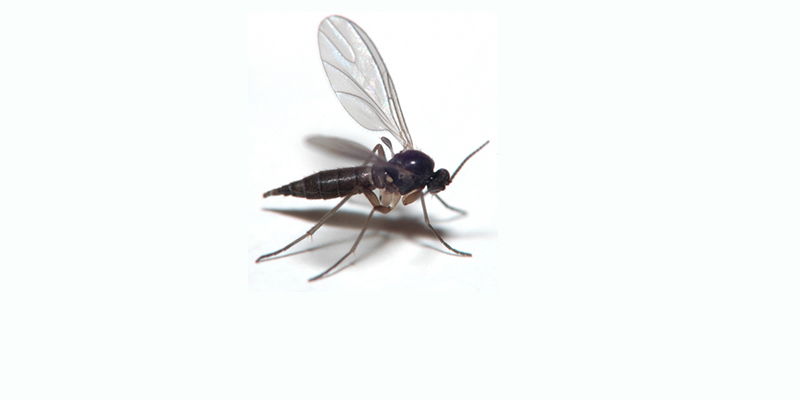

The major problem with fungus gnats is they allow your plants to be particularly vulnerable to lots of different fungal diseases.
Fungal gnat droppings are one of the things that cause major problems for your marijuana plants. The droppings, left in the soil, will affect your soil’s drainage and will, therefore, keep the soil too moist. This, in turn, attracts more pests that like the moist environment. Make sure you don’t get a total infestation by being careful not to water your marijuana plants too much.
Learn how to grow strong and healthy plants when you download my free grow bible!
Fungus gnats are attracted to your valuable plants in the first place by wet soil and decaying organic matter. This means that overwatering your plants or allowing the dead plant matter to rot will cause fungus to grow. This is often impossible to see with the naked eye – which in turn will invite fungus gnats to come feast and lay eggs.
If you’re receiving marijuana clones from elsewhere, you have to be absolutely certain that they don’t have any fungus gnats, spider mites, or other pests. If you are at all concerned about bugs being a problem, you should probably just grow your marijuana plants from seed. Clones are the easiest way of spreading pests to new crops, especially when you are growing indoors.
Treatment
Even if you have seen gnats flying around your plants, but the infestation hasn’t had any visible effects on your plant yet, it’s important to deal with the problem as soon as you notice fungus gnats.
You can try trapping the adult gnats by placing yellow sticky tape (available here) or sticky cards all around your garden. Gnat larvae, on the other hand, pose the real problem. First of all, make sure the top several layers of soil are allowed to fully dry. You will have to pause your normal watering schedule for a couple days – but it’s worth it. When the soil has dried, make a mixture of 3% hydrogen peroxide and water at a 1:4 ratio. This won’t injure your plants, but it will turn into oxygen and water (that, as you know, are beneficial to the soil). This will keep the gnats away while simultaneously helping your plants out.
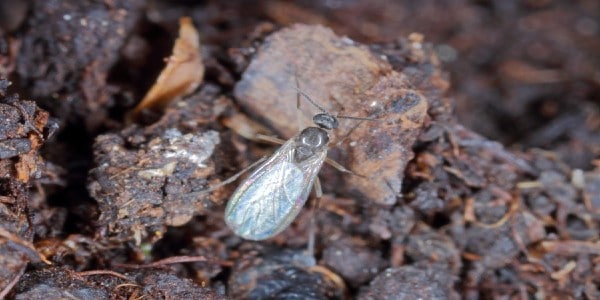

To help speed up the process of ridding your plants of this pest, bring in a fan and have it blowing over your soil to help dry it up more rapidly. It also helps keep the tiny fungus gnats from flying around properly, therefore reducing the amount of eggs they are able to lay. A commercial product like Bug Blaster will always to the job. If you want to make sure to kill them all buy something like Bug Blaster.
If you want to be particularly thorough, you can apply some food-grade diatomaceous earth over the areas of the soil that are exposed. This will kill the fungus gnat larvae, keep future infestations from occurring again, and will speed up the eradication process. Diatomaceous earth is organic – it’s simply made of fossilized shells! It kills insects effectively by cutting into their exoskeletons and draining out their bodily fluids. Luckily for you, it is not dangerous for people or pets – you could even consume it and be perfectly fine.
To protect your plants, I recommend to use Bergman’s Plant protector. These three bottles will feature everything you might need to make sure to protect your plants from, or get rid of, pests.


Bergman’s Plant Protector
- Protect your plants from diseases and harmful pests.
- Consists of three 20 ml bottles
- Enough plant protection system supplies for up to 20 plants
- Suitable for soil, hydroponic and all other grow mediums
Another way of destroying larvae that are living in the soil is using an actual pest treatment that contains the Bacillus thuringiensis bacteria. Bacillus thuringiensis sometimes referred to as “BT” or “BTi,” is a type of bacteria that creates a larvae-harming toxin. It essentially disallows them to eat.
The great thing about this bacteria is that, while it wreaks havoc on the tiny larvae, it won’t cause any problems for your plants or their roots. It also poses no threat to your own health. It is highly selective with where it focuses its harm – and it focuses almost exclusively on larvae. Make sure to crush the little pellets that you can buy and then sprinkle the resulting powder onto the soil from there. Dry formulations generally function better than liquids. When you do use this treatment, water your plants plenty afterward. This is a substitute for the hydrogen peroxide/water mixture that was described above.
Also read Cannabis pests & bugs – Control and identification
Once you have eradicated the fungus gnats from your garden, make sure to change your watering habits. Clearly you were overwatering, since that is what must have attracted the fungus gnats in the first place, so make sure to avoid this in the future so you won’t need to deal with another fungus gnat infestation – or worse.
You can keep using those yellow sticky cards to find out what the current status of the infestation is. If it has lowered, there will be fewer fungus gnats caught in the trap – and vise-versa. Don’t relax until you have hard evidence that the infestation is really gone. This could take a couple days, or it could take a few weeks! Don’t lose hope, and keep a careful eye on all the goings-on of the yellow sticky card as well as your garden itself.
Compost pile
It is somewhat common to discover fungus gnats and their larvae in your compost pile. It is something that you need to pay special attention to since compost is supposed to be there to make your plants strong and resilient – not destroy them from the roots up. So how do you deal with a fungus gnat problem in your compost?
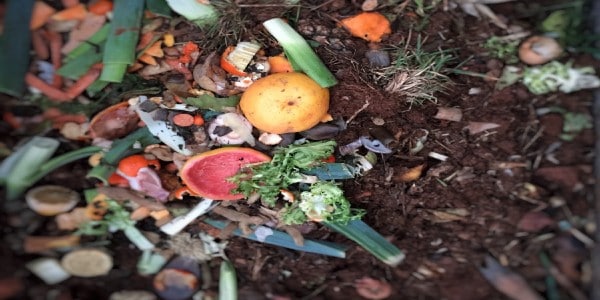

First, you need to ensure that your compost pile isn’t too moist. Excessive moisture is the primary reason for fungus gnats appearing in your compost pile, so take this piece of advice very seriously. A good rule of thumb is that compost piles shouldn’t seem wet, but they should be similar in moisture to a sponge that has been squeezed out.
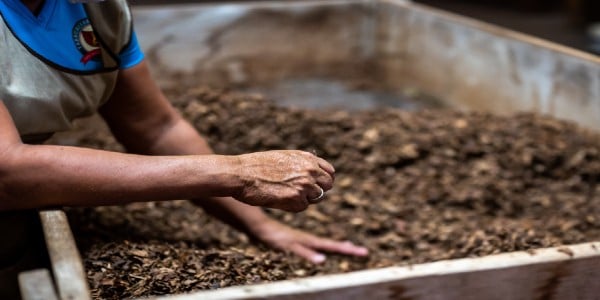

If you do discover those pesky larvae in your compost pile, you should try sprinkling food-grade Diatomaceous Earth over the exposed parts. This will cause no harm to people, but will kill off larvae and adult fungus gnats. If the problem is particularly extreme, try a pest treatment that has bacillus thuringiensis in it. Mosquito Bits or Mosquito Dunks are some examples of brands you could try. Use a dry formulation of this product rather than a liquid; break the pieces into a finer powder and sprinkle that over your compost. Then you add water (contrary to what we just told you about compost moisture levels), which will activate the treatment and will kill off the larvae.
Once you have allowed your compost pile to dry out enough, make sure to cover it up with some sort of plastic covering or tarp. If nothing else, this will mess with the fungus gnat life cycle, further weakening them and slowing down the infestation. Another way of accomplishing the same thing is covering it with a material containing plenty of carbon. Some examples of this are cardboard, shredded paper, brown leaves, or even mushrooms. If possible, you should have a lid over your compost bin from the beginning, therefore preventing the infestation from happening at all.


To really prevent this, do not add your kitchen scraps to the compost pile if you’re going to be using it for marijuana plants. The best marijuana growth comes from compost that has been maintained properly. This means avoiding kitchen scraps or burying them in the middle of the pile so fungus gnats or other pests can’t reach it.
Ensure that your compost pile is turned over often and consistently, therefore allowing it to dry out enough and keeping everything mixed up. This also will keep the fungus gnat larvae from getting too problematic, in case they have already found their way to your delicious compost pile. If the compost is maintained correctly, it will increase significantly in temperature. This, finally, will roast the remaining larvae, causing them to certainly meet their demise.
Marijuana plant symptoms


How to recognize marijuana plant symptoms caused by fungus gnats
Leaf color
- Edges brown or burnt
- Pale color
- Yellowing of new growth
- Black or gray patches
- Brown, dark spots
Leaf symptoms
- Upper leaves affected
- Newer growth affected
- Small inner leaves affected
- All leaves might look affected
- Leaf edges burnt
- Yellow between veins
- Spots
- Slowed growth
- Twisted, abnormal growth
- Leaves curling under
- Wilting & drooping
Plant symptoms
- Slowed growth
- Wilting & drooping
- Twisted, abnormal growth
- Slowed growth of roots
- Bugs
- Buds not getting fatter
Plants with strong genetics have less chances of getting sick and are less vulnerable to pests and diseases. I have created multiple grow sets which features all you need in order to grow healthy plants from seed to harvest!
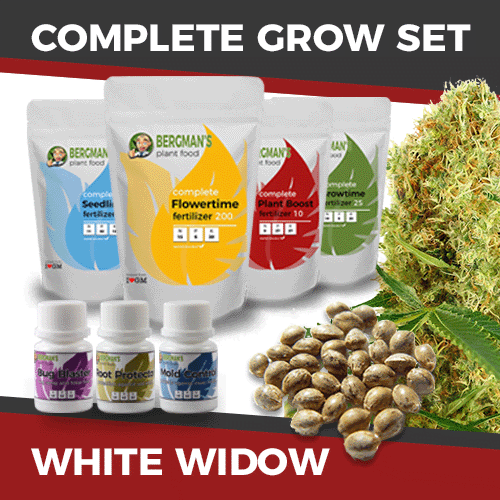

Get your grow set
- Everything you need to grow your plants!
- 20 feminized seeds
- Marijuana Fertilizer Set for 5-10 plants
- Plant Protector for 20 plants
Fungus gnats are commonly mistaken for fruit flies – make sure you are aware of which one is buzzing around your marijuana plants. Fruit flies and fungus gnats have very different behaviors (and, therefore, different deterrents), so it’s important to know which one you are dealing with.
Fruit flies have bodies that are brown, yellow, or orange in color; fungus gnats are gray, dark brown, or black. Fungus gnats will appear particularly tiny to you while fruit flies are generally larger and easier to spot.
If your problem is due to fruit flies instead of fungus gnats, you will need to take a different approach to ridding your growing area of them. They are attracted by ripe or rotting fruit (thus their name), as well as improperly composted soil that has your kitchen scraps in it. If you take this food away from them, they will also go away.
FAQs about fungus gnats
What attracts fungus gnats to my plants?
Fungus gnats are attracted to your cannabis plants by wet soil and decaying organic matter.
How do I get rid of fungus gnats on my cannabis plants?
Controlling soil moisture, using yellow sticky tapes to trap them, and using soil covers are some ways to get rid of fungus gnats.
At what temperature will fungus gnats die?
Generally, fungus gnats can die at any temperature below -25 degrees Fahrenheit. There are some species, though that can possibly survive up to -60 degrees Fahrenheit.
You only need practice and learning to grow marijuana like a pro! Visit my blog to get answers to your growing questions.
What method have you tried to get rid of fungus gnats? Please share your experience or leave questions below.
Happy growing!
Robert
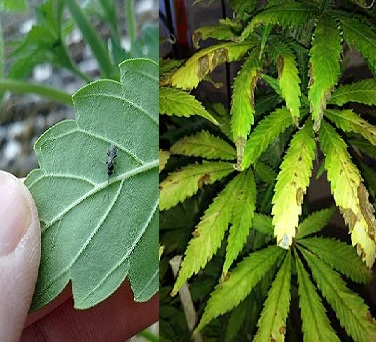
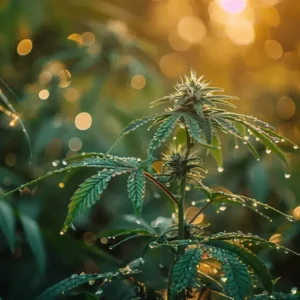
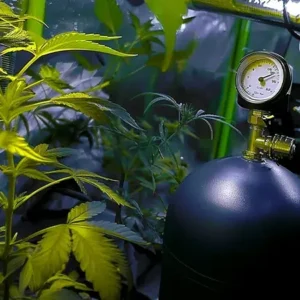
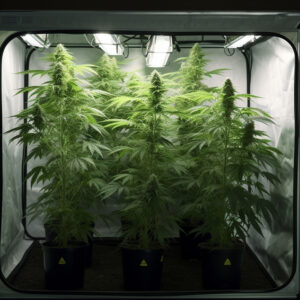
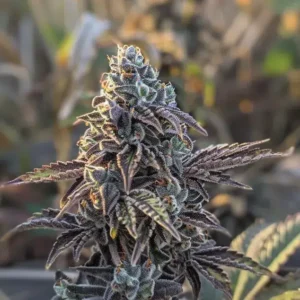
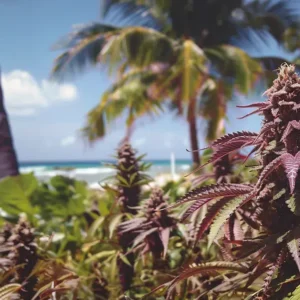
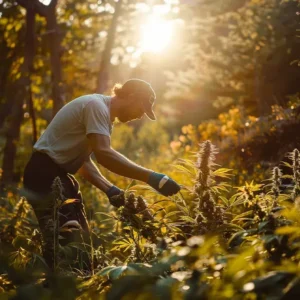
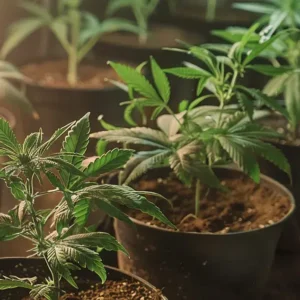
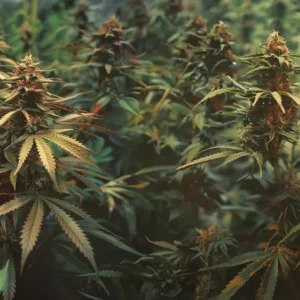

Hydrogen peroxide water once a week. Works very well
Will sticky fly paper strips work as a substitute for the cards? And what about my ladybugs… Sure don’t want to hurt them. Also curious if a layer of ground egg shells would work. Please advise. Thank you!
After applying the crushed BTI, do you need to use just water or could you water with a tea + microbes? When is the best time to apply diatomaceous earth, between feedings when the top is more dry? Is it ok to feed after applying?
What if your trimming and the. Find them? What do I do? Does it impose. Threat as well to my home if I am trimming indoors? Is it ok to smoke still?
I ran the peroxide/water ,mixture and put an inch of tiny sharp rocks, but the plant looks real bad. Curling leaves. I am not watering for a week and see if they bounce back? Will they bounce back? Years of doing this and never had this problem.
My plants look like they have some sort of small maggots (white) in the soil. How do i get rid of them?
Im pretty sure I have fungus gnats I was hoping to find out how to get rid of them
Hi Robert… I am dealing with fungus gnats and want to treat with diatomaceous earth. How much should I apply to a 2 gal. Pot ?
will cinnamon effect the taste of the buds?
I used egg shells instead of Diatomaceous earth and I have seen a reduction in the adults. How can I tell if it is working on the larve?
is apple cider vinegar and dish soap mixed with water a good gnat killer?
G man here I’ve a gnat problem bought 35% food grade peroxide deluded it. To 4-5% didn’t work i put sand on top didn’t work bought fly paper traps trapped quite a lot also just tried yellow sticky traps they work now going to try some bacillus thuringiesis bacteria. Plants need to get transplanted for final time from 1.5 gal to 5gal.1st grow 4 northern lights extreme….gotta get rid of pesky gnats…lotta great info.in here
I can’t seem to figure out what is eating on my young plays leaves
This is a tried & true method.
Buy washed/clean sand used in children’s sandpits.
Rinse thoroughly to remove any salts etc.
Apply min 10mm or 3/8 inch.
Can make watering a little tricky, but well worth it.
Instant results.
I have read all of the above suggestions for gnats – I’ve been trying and trying, with no luck. The peroxide didn’t seem to do anything, so I went and bought a bag of the diatomaceous earth and sprinkled that over the top of the soil. I have also been using the bug blaster as a spray on the plant and soil. There are still gnats all over the place. This is my one and only plant that I have going…. if I lose it I’ll die!
Can you get in touch with me ? Regarding an order I sent . Regards Allan .
Very informative.. You obviously know your stuff..
im happy , flys not 🙂 thx
I found that I had these little white mite thingys crawling around and discovered that as my fungus gnat population fell that there was more of these mites. well, what I discovered was that I had a predatory mite called hypoaspis miles. they seek out fungus gnat larvae and eat them. along with hydrogen peroxide treatments, they are eradicated!!
Definitely have a fungal gnat issue , gonna try some of the rememdies that ive read here .. the new growth in the tips looks brownish and it starts from the bottom of the plant and goes upward .. some of my flowering plants are looking like they’re dying and its gotta be these fucking gnats .. ph is perfect and definitely not a nutrition issue .. I see a decent amount of adults flying and crawling on top of the soil .. so im hoping once I get control of them I won’t have any other problems..
Sounds to me like you have a PH or nutrient toxidity issue as well.
The damaged plant will only recover so far as to say, in it’s new growth. The damaged area will always look like it does. If you can get the pests cleaned up; You need to wait and most likely treat the plant again, once the eggs already laid in the plant hatch. Once you clean out those hatchlings you should be able to induce flower..
If I’m dealing with a fungus gnat problem where my 3 week old veg plants have withstood the invasion but is showing moderate but not severe damage, still slowed growth yellowing drooping. Twisting but has most of its roots already in place but seemed definitely impacted by these fuckers. Will the plant recover to its full potential? And after the problem is fixed and dries out. How long should I waitIt to start flowering? If I have all my branches in place and topped. Will they recover to normal growth again? ??
I love this site. When I have a problem, I come here. There’s always an answer to my question. Sound advice that I trust every time. The solutions work. I love that most,are just home remedies. Thanks much for all the help. And thanks much for the FREE grow bible. Awesome!!
It is impossible to guess and diagnose the issue you described without pictures. Join our support forum and post a topic with a picture or 2. This will allow us to give you an informed answer.
I’ve not seen any flies but I have got orange fungus very small clusters and they go pale when they dry.. I’m getting worries I case it’s on the roots.. I scooped 2 inches of the top soil away and put in a layer of dry new soil.. The plants genetics must be amazing… I found a seed in a bag of smoke.. Put it in damp tissue it split within 6 hours.. After around 12 hours it had a root half inch long poking out.. I potted it an inch deep in soil.. Watered it a little and the next day it sprouted two little round leaves.. It’s gone from that to having its third set of true leaves in a week.. Yesterday I gave it it’s first dose of nutes.. Even just 24 hours later it’s growth is rapid.. Very unexpected and didn’t even expect it to grow hahaha paranoid now incase it goes south from fungus.. Help
On some grows I have had infestation of fungus gnats. One time I tried using the hydrogen peroxide and water solution but I had some limited success, that is the gnats disappeared only to reappear later. The last time I had a fungus gnat infection I read that cinnamon sprinkled on top of the soil works. I had 3 in DWC and 1 in soil. I sprinkled the cinnamon on top of the soil and the expanded clay pellets and it worked like a charm. It took about 2 weeks but all the fungus gnats disappeared.
We all love home remedies. As long as they work. 🙂
I’m wondering if fungus gnats can ruin the taste, causing your crop to have zero flavor and zero smell? Diotamacious earth works great I know I’ve used it many times in the past.
UNfortunately; I have to say;
If you harvest bugs, harvest will taste like bugs; IN at least part of the grow.”
However; If no nest has been built in your foliage, or, buds; You may not realize any significant damage to the finished herb.
I do not believe that quality would be effected as long as their is not infestation in the foliage. 🙂
Join our support forums for a wider range of opinions and support
This is some good stuff. It took me some time to locate this blog but it was worth the time. I nitecod this website was buried in google and not the first spot. This internet site has a lot of good stuff and it doesnt deserve to be burried in the searches like that. By the way Im going to save this site to my favorites.VA:F [1.9.17_1161]please wait…
We are so glad that you appreciate the efforts of ILGM Staff and Workers.
[…] Fungus gnats […]
[…] layer of your soil (about an inch deep) dry completely after each watering. This should keep the fungus gnats […]
[…] Thankfully, even though the fungus gnats can be nigh impossible to spot, there is an easy method to check for them. All you have to do is put out a sticky pad near the base of the cannabis plant to catch the larvae. This won’t totally fix the problem, but it’ll get a lot of them. To finish up, mix a little bit of peroxide and water and apply that to the area where the fungus gnats are located. Read more about Fungus gnats on marijuana plants […]
Grow Clean works wonders on any gnats flying around!!
Best way to proacvtively rid your plants of soft shelled insects is: Food Grade Codex Diatomaceous Earth.
What do u think of the gnat nix, is a physical barrier I’m using it in my garden I just started using though have you had any expirience also won’t hydrogen peroxide kill good bacteria and micorrizae?
I use about a 3/4 inch of perlite on the top of all my container plants and it seems to work real well along with hydro peroxide treatments every couple of weeks.
I have a few fungus gnats. Caught some with yellow stickys. Got good results with hydrogen peroxide but I’m wondering if a garlic solution would be effective on the larvae….
I have been trying TaNLin which appears to be controlling the larvae. Have not observed any flying insects – I did catch them early hopefully I will get a harvest!
Keep temperature of the nutes at 21c any higher and you run the risk of aphids.
I been grow for 40 years and everything in here is right on thanks for the good knowledge and information happy growing everybody
I got little Root Aphids? How do I get rid of them?
Do you have any solutions for root aphids. I am growing in a deep water reseviour and have been infested!
Thank you so much for your knowledge and help! Your tips are greatly appreciated.